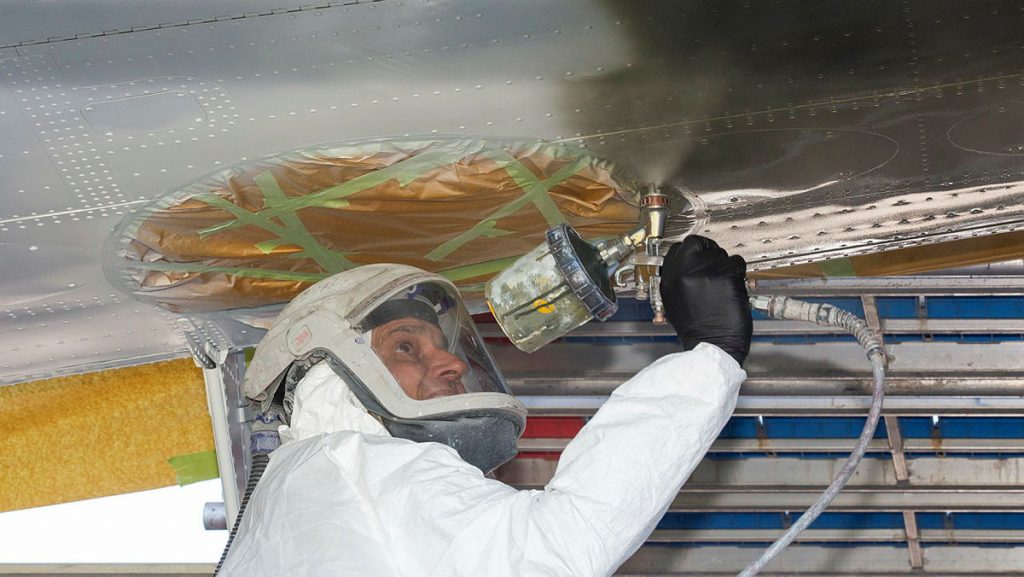
A team of RAAF reservists has completed a seven-month project to restore the exterior of a Caribou that was left unattended for years.
Warrant Officer Mike Downs led the team that chemically and mechanically removed old paint from A4-236, which had degraded to a “sub-standard state”.
It will now be placed on display during public open days at Amberley Aviation Heritage Centre (AAHC), before work begins on upgrading its interior.
RAAF ordered its first Caribou in 1963 to replace its existing Dakotas, with a total of 29 acquired over the years.
It was built in Canada by Hawker de Havilland but focused on being able to land on rough dirt runways right near the battlefield.
When the last remaining aircraft were retired in 2009, many surviving Caribou made their way into museums and heritage centres, including the Australian War Memorial and RAAF Museum at Point Cook.
A4-236 was handed over to the AAHC and WOFF Downs headed the project having worked on the Caribou at No. 38 Squadron in 2009.
“For a number of years, the aircraft was left unattended before being transferred to the custody of the AAHC,” WOFF Downs said.
“In the ensuing years, the aircraft exterior paint finish deteriorated to the point where bare metal was visible and the aircraft was deemed as sub-standard for an AAHC static display.”

When A4-236 arrived at RAAF Base Amberley in November 2009, only a “cursory effort” was made to preserve or protect the aircraft while it was parked in the elements.
However, in recent years, Air Force’s History & Heritage Branch has initiated a project to restore many of the retired aircraft at RAAF bases around Australia.
The Branch’s static display aircraft support section (SDASS) works to bring the aircraft to a display standard.
“Work [on A4-236] commenced on August 30, 2021, with the removal of the wing-mounted flight controls,” WOFF Downs said.
“Following this task, a civilian contractor erected a complex scaffolding assembly that allowed SDASS personnel to safely access every part of the aircraft exterior from the nose ‘bonnet’ to the tip of the tail at about 10 metres high.
“The next task was arguably the most arduous of the entire project – stripping the existing paint from the aircraft’s entire upper surface.”
The SDASS team is comprised of RAAF reservists with an average service career of 32 years and a technical background.
The group spent five weeks painstakingly removing old paint, sanding the newly exposed surface and removing all remnants of oil, grease and dirt.
Using environmentally safe products, the SDASS team removed the existing paint on the Caribou and disposed of it using an approved contractor.
“This process was necessary to ensure paint adhesion for the new livery,” WOFF Downs said.
“From mid-October to Christmas 2021, the team was fully engaged in masking, priming and painting of the aircraft in an olive-green gloss finish and applying No. 38 Squadron markings. About 200 individual paint stencils and decals were also applied to the aircraft.”
Throughout its 44-year career, A4-236 wore many liveries and markings, including an all-white United Nations scheme in the early 1990s, a planned deployment to Cambodia that didn’t eventuate for the Caribou.
In the 1990s, it received a green and black “lizard scheme” that was carried through operations in East Timor and the Solomon Islands until its retirement.
For its refurbishment, a gloss olive-green finish was applied to showcase the aircraft as it appeared in 1983, including a prominent blue-and-white No. 38 Squadron flash on the tail.
The livery echoes the earlier refurbishment of Caribou A4-199 at RAAF Base Townsville, which is displayed in a similar No. 35 Squadron livery.
The team is now turning its attention to the aircraft’s interior.
“This will allow visitors to AAHC to experience the full Caribou ambiance by allowing walk-through access on open-days at the centre,” WOFF Downs said.
Once completed, Caribou A4-236 will feature in the AAHC alongside other RAAF aircraft with a strong connection to the Brisbane area such as an F-111 and the Iroquois helicopter.
The Caribou is considered one of the most iconic aircraft in the RAAF’s history, and could carry 32 armed troops, 22 stretcher cases, two Land Rovers or up to 4 tonnes of supplies.
Its large rear access ramp made it easy to be opened in flight to allow paratroopers to jump out or cargo to be dropped.
Chief of Air Force Air Marshal Mel Hupfeld sang the praises of the Caribou to Australian Aviation in 2020.
“From 1958 to 1973 the Air Force acquired new maritime patrol aircraft, fighters, heavy airlift capability, battlefield helicopters and new strike platforms,” he explained.
“In contrast to these new aircraft with their modern avionics and sensor systems, the Caribou with its 1930s era engine design, basic avionics and unpowered flight controls seemed something of an anachronism.
“Yet for all of its simplicity, the rugged design and STOL capability of the Caribou meant it was ideal for operations in remote regions within Australia and across the Asia-Pacific region.”
The aircraft saw service in Vietnam when three landed at Vūng Tàu on Vietnam’s east coast in 1964.
















chris
says:I still have an original DHC brochure for the Caribou, circa 1962, featuring the prototype.